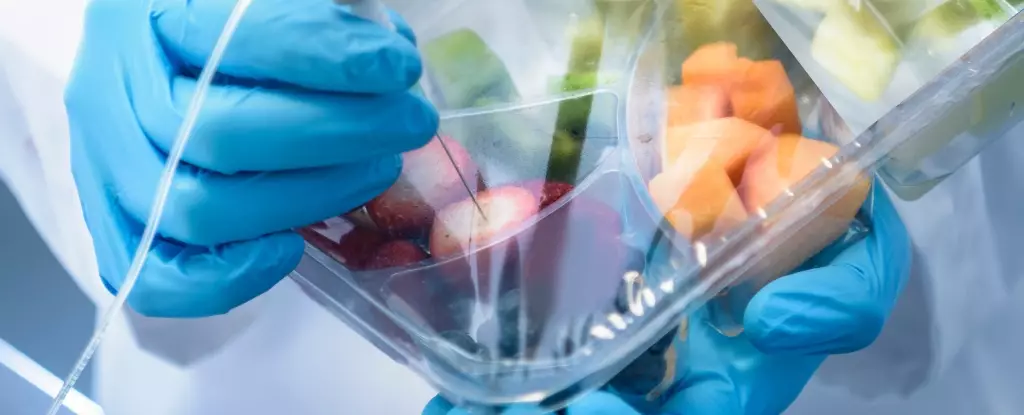Recent findings published in a study have cast a dark shadow on the safety of food packaging materials, revealing that over 3,600 chemicals used in the preparation and packaging of food products have been detected in human bodies. The study’s lead author, Birgit Geueke from the Food Packaging Forum Foundation in Zurich, highlighted the fact that approximately 100 of these chemicals raise significant health concerns. This revelation underscores the vital need for public awareness and further investigative research into the impacts these chemicals may impose on human health.
Chronic exposure to these chemicals, some of which have already been linked to serious health issues, raises questions about the everyday items we take for granted. Common substances like PFAS (per- and polyfluoroalkyl substances) and bisphenol A (BPA)—both recognized as hazardous—have prompted bans in many jurisdictions, but the broader implications of the multitude of other chemicals remain largely unexplored.
The research team’s impressive cataloging achievement included nearly 14,000 food contact chemicals (FCCs), which possess the potential to “migrate” from packaging materials into food. These chemicals can originate from multiple contributors: plastic, paper, glass, metal packaging, and even equipment like conveyor belts and kitchen utensils involved in food preparation.
When the researchers analyzed existing biomonitoring databases, anticipating the identification of a few hundred FCCs, they were taken aback to discover 3,601 distinct chemicals present in human biological samples. This considerable number accounts for nearly a quarter of the total known FCCs, accentuating the pervasive nature of chemical infiltration into our bodies through the food we consume.
Geueke noted a crucial caveat; while these chemicals have been detected in humans, the study did not conclusively determine that food packaging was the sole source of exposure. There are numerous pathways through which these chemicals could enter the human body, making it imperative for further investigations to pinpoint their origins.
Among the identified chemicals, numerous PFAS have gained notable attention due to their affiliations with diverse health problems, including hormone disruption and fertility issues. The study’s findings extend to bisphenol A—a pervasive chemical found in plastics and now prohibited in baby bottles across various countries—along with phthalates, which are also known for their associations with reproductive toxicity.
Of particular concern are oligomers, byproducts of plastic manufacturing, where the existing evidence regarding their health impacts is scarce. Geueke remarked on the shocking lack of research surrounding these substances, highlighting a critical gap in our understanding of potential risks.
The age-old toxicological maxim, “the dose makes the poison,” still rings true, as the study points out that it could not ascertain the concentrations of these chemicals within the human body. However, the potential for these substances to interact with one another poses additional risks. Geueke’s mention of one sample containing up to 30 distinct PFAS amplifies the concern for compounded health effects.
Recommendations for Reducing Exposure
In light of these alarming findings, Geueke has urged the public to minimize contact with food packaging materials, particularly encouraging individuals to refrain from warming food directly in its packaging. Such steps may reduce the risk of chemical transfer during heating processes, allowing consumers to take control of their exposure levels.
Duane Mellor, an expert in evidence-based medicine at Aston University, praised the comprehensive nature of the study while advocating for more precise data regarding the extent of exposure. He emphasized the necessity for consumers to remain informed and proactive rather than succumb to unwarranted anxiety about these revelations. Mellor encouraged the demand for better regulatory measures to ensure public health safety.
The Regulatory Landscape: Progress and Challenges
As the awareness surrounding these chemicals grows, regulatory bodies are beginning to take action. The European Union is currently finalizing a ban on the use of PFAS in food packaging, alongside proposals for a similar ban on bisphenol A. These regulatory efforts are crucial steps toward safeguarding public health and preventing unnecessary chemical exposure.
The study sheds light on a pressing public health issue that demands immediate attention. As consumers, we must remain vigilant, advocate for transparent research, and engage in conversations regarding the safety of food packaging materials to foster a healthier environment for all. The blend of awareness, research, and regulatory progress will play a pivotal role in safeguarding our health from the unseen dangers of food packaging chemicals.


Leave a Reply